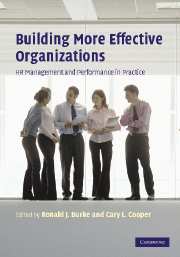Book contents
- Frontmatter
- Contents
- List of figures
- List of tables
- List of contributors
- Foreword
- Preface
- Acknowledgements
- Part I Building more effective organizations
- Part II Enhancing individual health and performance
- Part III Enhancing organizational health and performance
- 6 Maximizing the value of leadership development: key questions (and some answers)
- 7 Best practices in building more effective teams
- 8 Career development processes in organizations
- 9 Fostering organizational learning: Creating and maintaining a learning culture
- 10 Work–life balance, best practices and healthy organisations: A European perspective
- 11 Diversity management practices in leading edge firms
- Part IV Transforming organizations
- Index
8 - Career development processes in organizations
Published online by Cambridge University Press: 05 June 2012
- Frontmatter
- Contents
- List of figures
- List of tables
- List of contributors
- Foreword
- Preface
- Acknowledgements
- Part I Building more effective organizations
- Part II Enhancing individual health and performance
- Part III Enhancing organizational health and performance
- 6 Maximizing the value of leadership development: key questions (and some answers)
- 7 Best practices in building more effective teams
- 8 Career development processes in organizations
- 9 Fostering organizational learning: Creating and maintaining a learning culture
- 10 Work–life balance, best practices and healthy organisations: A European perspective
- 11 Diversity management practices in leading edge firms
- Part IV Transforming organizations
- Index
Summary
Traditionally, organizational career management programs have been based on the premise that the organization was comprised of individuals who planned to spend their entire work life within that same workplace. This premise stemmed from early career stage models that depicted workers as being focused on upward movement within a clear and stable structure with one or two employers over their life spans (e.g., Super, 1957). Such traditional models suggested that paternalistic employers offer resources to its employees to enable these individuals to repeatedly win rounds in the career tournament (see Ng et al., 2005 for a review; Nicholson and De Waal-Andrew, 2005; Rosenbaum, 1979). Likewise, emphasis was placed on how certain factors, such as having a mentor (Kram, 1985; Forret and de Janasz, 2005), could enhance career outcomes, especially salary and rate of promotion (Feldman, 1990; Sullivan and Arthur, 2006).
However, over the last twenty-five years, the work landscape has dramatically changed (Baruch, 2004; Hall, 2002). Demographic shifts (Bureau of Labor Statistics, 2004a&2004b), increased globalization (Bartlett and Ghoshal, 1989), the increased rate of technological advances (e.g., Friedman, 2005; Kanter, 2001) changes in the psychological employment contract (Rousseau, 1989; Rousseau and Wade-Benzoni, 1995; Conway and Briner, 2005), and the fundamental uncertainty of the career environment have called into question assumptions about traditional linear careers (Arthur and Rousseau, 1996; Cappelli, 1999; Hall, 1996; Osterman, 1996; Weick, 1996).
- Type
- Chapter
- Information
- Building More Effective OrganizationsHR Management and Performance in Practice, pp. 183 - 206Publisher: Cambridge University PressPrint publication year: 2007
- 1
- Cited by



